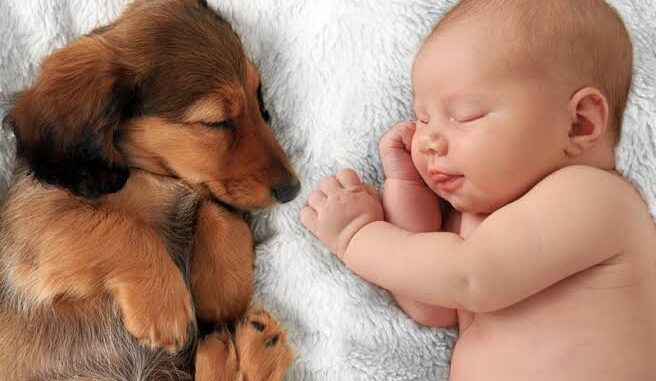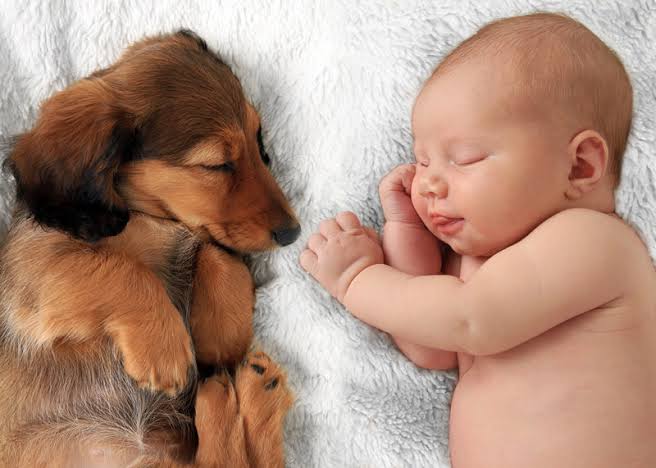
How to Introduce a Dog to a New Baby: Introducing your dog to your new baby can be one of the most joyful and nerve-wracking moments of your life as a pet parent. Your dog, a beloved member of your family, is about to meet someone who will completely change your daily routine, your attention, and the dynamics of your home. Planning this introduction with care is essential to ensure both your baby and your dog start their relationship on the right paw.

This guide will take you through the importance of preparation, step-by-step introduction strategies, common mistakes to avoid, and how to build a lasting bond between your baby and your dog.
Why Planning the Introduction Matters
Dogs thrive on routine and predictability. The arrival of a baby brings noise, smells, and a lot of sudden changes all of which can be overwhelming. A well-prepared introduction can:
- Reduce anxiety and confusion for your dog
- Prevent territorial or aggressive behavior
- Set the stage for a lifelong bond between your child and your dog
- Help maintain a peaceful and safe home
An unprepared dog may become jealous, stressed, or even defensive, especially if they feel neglected or displaced. Preparation is key.
Understanding Your Dog’s Perspective
Dogs don’t understand human life stages. To them, a baby is a strange new creature—crying loudly, moving unpredictably, and taking up your time and affection.
Here are some things your dog may be sensitive to:
- New scents (baby lotion, powder, diapers)
- New sounds (crying, cooing, lullabies)
- Less attention or walks
- Restricted access to parts of the house
- More visitors and commotion
Being empathetic to your dog’s experience will help you approach the situation with compassion and patience.
Preparing Before the Baby Arrives
Preparation should start weeks before your due date to give your dog time to adjust gradually. Here are the critical steps:
A. Brush Up on Basic Obedience
Commands like sit, stay, down, leave it, and come should be solid before the baby arrives. These commands help control interactions calmly.
B. Desensitize to Baby Sounds
Play recordings of baby noises—crying, laughing, screaming—at increasing volumes while rewarding your dog for staying calm.
C. Introduce New Smells
Apply baby lotion or powder to your skin and let your dog sniff it. Bring out baby blankets, swings, or toys and let your dog explore them under supervision.
D. Adjust Routines Gradually
If walks or feeding times will shift after the baby arrives, start changing them now. Slowly introduce changes like less lap time or solo play.
E. Set Up Boundaries
Install baby gates or close doors to create off-limits areas. This teaches your dog where they are and aren’t allowed before the baby comes.
The First Introduction: Step-by-Step
When your baby finally arrives, the first meeting with your dog should be calm, controlled, and non-threatening. Here’s how to do it right.
Step 1: Return Home Without the Baby
Have one parent or family member come home alone first to greet the dog. Let them get out any pent-up energy through a walk or play session.
Step 2: Let the Dog Smell Baby Items
Before the physical introduction, let your dog sniff a blanket or onesie that smells like the baby.
Step 3: Controlled Introduction
Have the dog on a leash (but not pulled tight) and let them see and sniff the baby from a distance. Speak calmly. Praise your dog for calm behavior.
- Do not force interaction
- Keep the mood quiet and relaxed
- Reward the dog with treats and affection
Step 4: Close Proximity (Optional)
If your dog seems calm, allow them to come closer and sniff the baby. Always monitor body language. If the dog is overly excited or nervous, take a break and try again later.
Establishing New Routines
Consistency is comforting for dogs. After the baby arrives, try to maintain a version of the dog’s routine for:
- Feeding times
- Daily walks
- Play sessions
Tips:
- Use a baby carrier or stroller to walk your dog with the baby
- Schedule short one-on-one time with your dog daily
- Use puzzle toys or treat dispensers to keep them mentally engaged
This helps your dog feel included, not forgotten.
READ ALSO: 5 Dog Training Myths You Should Ignore
Promoting a Safe and Positive Bond
As your baby grows, your dog will become curious. You can gradually build a positive association between the baby and good things.
Do:
- Praise and reward your dog when they behave calmly around the baby
- Let them observe baby activities from a distance
- Involve your dog in routines (e.g., sitting near you during feedings)
Don’t:
- Punish your dog for showing curiosity
- Force physical interaction
- Leave baby and dog unsupervised—ever
With time, your dog will likely accept the baby as part of their “pack.”
Signs of Stress or Trouble
Watch your dog for these warning signs that they’re overwhelmed or anxious:
- Excessive panting or drooling
- Growling, snapping, or baring teeth
- Avoidance or hiding
- Destructive behavior
- Whining, barking, or pacing
If these behaviors persist, consult a veterinarian or certified dog behaviorist. Do not assume they will just “adjust on their own.”
FAQs
What if my dog is overly excited or jumpy?
Use a leash or baby gate to control the introduction. Practice “sit” and “stay” with high-value treats. You may need to burn off energy with exercise first.
Should my dog be allowed in the nursery?
It depends on your comfort. If you allow it, supervise at all times and create a calm environment. If not, train your dog early to respect that boundary.
How long does it take for a dog to adjust?
It varies. Some dogs adjust in days, others take weeks or even months. Stay patient, consistent, and supportive.
Can small dogs be aggressive toward babies?
Yes. Size doesn’t determine behavior. Some small dogs can be territorial or snappy. All dogs—regardless of size—should be introduced carefully.
My dog growled when the baby cried. What should I do?
Growling is often a sign of stress, not aggression. Separate the dog calmly and reward calm behavior during crying sessions. Gradual desensitization with sounds may help.
What if I have multiple dogs?
Introduce them one at a time, not as a group. Each dog should have its own chance to meet the baby calmly.
Should I change how I show affection to my dog?
Not drastically, but expect that your time and attention will shift. Use brief, focused moments of affection and play. This reassures your dog they are still loved.
Can I hire help for the transition?
Absolutely. A dog trainer, canine behaviorist, or even a dog walker can support the adjustment process and reduce your stress.
What about future interactions when the baby starts crawling?
As your baby grows more mobile, continue supervision. Teach your child to be gentle, and create safe zones for your dog to retreat to when overwhelmed.
Is rehoming ever necessary?
In rare cases such as repeated aggression or danger to the baby rehoming may be the safest choice. But this is a last resort and should only happen after consulting with professionals.
Leave a Reply
You must be logged in to post a comment.